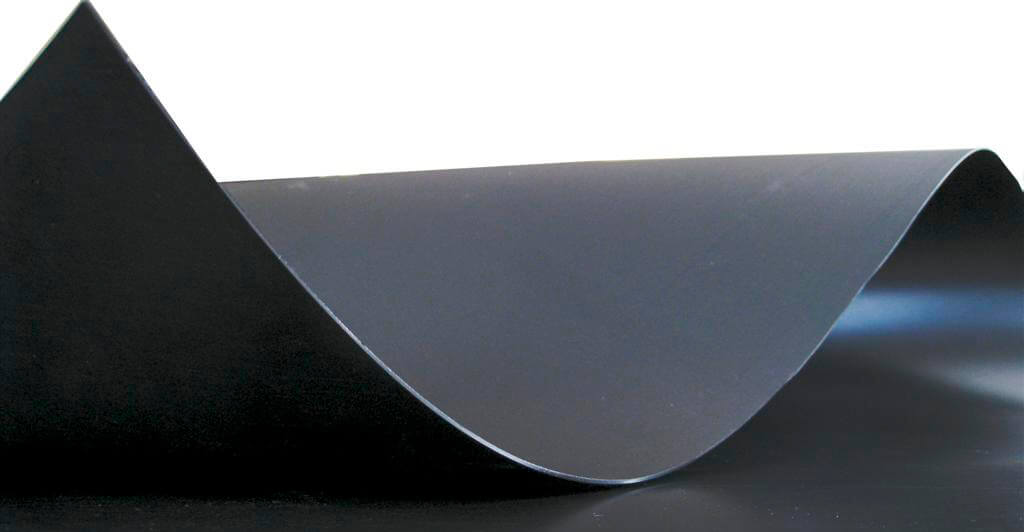
Published 21/04/2021
High density polyethylene
HIGH DENSITY POLYETHYLENE GEOMEMBRANES (HDPE)
What are High Density Polyethylene Geomembranes?
HDPE geomembranes gained popularity over traditional PVC geomembranes in the early 1980s due to their high chemical resistance, their durability and their ability to be thermally welded rather than adhesively bonded. At that time, PVC geomembrane welds delaminated while HDPE thermal fusion welding did not.
In practice, HDPE is currently the most widely used material for geomembrane manufacture. High Density Polyethylene (HDPE) is a thermoplastic polymer obtained by the polymerisation of ethylene. As one of the most versatile plastic materials, HDPE plastic is used in a wide variety of applications, especially in hazardous waste containment and water storage.
Known for its excellent tensile strength and high strength to density ratio, HDPE has a high resistance to impact, ultraviolet radiation, weathering and corrosion.
HDPE geomembranes are of obligatory application and have become the world standard for environmental protection: new cells and sealing of landfills and in general all those applications in which the conjunction of three fundamental properties is required: maximum chemical resistance, maximum resistance to weathering (ultraviolet radiation and ageing due to atmospheric thermal cycles) and impenetrability to most gases which, in this type of application, are usually present together with the product to be contained.
High density polyethylene uses
By extension and given its speci?c characteristics, it is also the product par excellence in applications for Water Storage and Hydraulic Works in general (canals, lagoon purification, golf course lakes, aquaculture...).
These are some of the most common applications of HDPE geomembranes:
- Landfill - solid waste.
- Landfill - liquid waste.
- Landfill capping.
- Biogas digesters.
- Cutoff Walls.
- Secondary containment.
- Heap Leach Pads.
- Tailings dams.
- Red mud dams.
- Mining process ponds.
- Water ponds.
- Channels and Water Conveyance.
- Evaporation ponds.
- Aquaculture.
- Ornamental lakes.
- Other hydraulic and geotechnical applications.
- Erosion Control.
What are the benefits of HDPE geomembranes?
High Density Polyethylene Geomembranes (HDPE) manufactured by ATARFIL have proven to be able to offer maximum efficiency thanks to their high strength and durability, they are suitable for the protection of the environment from toxic waste in the short, medium and long term.
One of the most outstanding properties of HDPE geomembranes is their resistance to Stress Cracking (SCR). SCR is the property of HDPE that determines its long-term mechanical durability and its resistance to mechanical damage due to stresses imposed during welding. This problem is mitigated by ATARFIL HD geomembrane with a resistance to stress cracking (>3000h).
Properties of High Density Polyethylene, HDPE
- Easily meltable and mouldable
One of the main benefits of HDPE comes from its malleability. Due to its high melting point, HDPE remains rigid up to very high temperatures. However, once it has reached its melting point, the plastic material can be moulded quickly and efficiently.
- Corrosion resistance
High density polyethylene resists mould, corrosion and rot. HDPE can withstand most strong mineral acids and bases and has excellent resistance to chemicals found naturally in soil. In addition, the material is virtually impervious to most common chemicals, water, solvents, acids, gases, detergents and cleaning fluids.
- High strength to density ratio
The density of HDPE can range from 0.93 to 0.97 g, although the density of HDPE is only marginally higher than that of LLDPE (linear low density polyethylene), however, the linear structure of HDPE shows that the material has little branching, which gives it stronger intermolecular forces and higher tensile strength than LLDPE.
It is for this reason that a 60 gram HDPE container can safely hold almost four litres of liquid or approximately three and a half kilograms in weight.
- Easily recycled
Considering the amount of plastic we use in our daily lives, one of the most important factors when deciding on a plastic material is whether it is easily recyclable. High density polyethylene is one hundred percent recyclable, so it has the advantage of being an environmentally responsible material.
- Durability
HDPE resin is currently the worldwide standard for containment due to its long-term durability in a wide range of site conditions. Given by a very good overall chemical resistance, UV resistance, versatile mechanical properties as well as its competitive cost.
In terms of HDPE resin properties, its long-term durability is a function of their Environmental Stress Cracking Resistance (ESCR) of the specific grade of HDPE resin used. Therefore, the ESCR is the most limiting material property for HDPE. The ESCR is the single most important property of HDPE that determines its long-term mechanical durability and its resistance to mechanical damage due to stresses imposed during welding. This material constraint will be mitigated selecting a geomembrane with very high ESCR (e.g. >3000h).
Why choose ATARFIL HD polyethylene geomembranes?
ATARFIL HD Geomembranes offer a safe waste containment and water storage solution ideal for application in all types of sustainable and affordable projects. ATARFIL HD offers a balanced combination of strength, cost-effectiveness and environmental friendliness.
At Atarfil quality is a term that is considered a starting premise and is therefore assumed from the outset. We believe that a product for Safe Containment applications does not allow for intermediate quality solutions, which is why Atarfil carefully selects the raw materials from the world's most reputable suppliers to be transformed into its geomembranes, leaders in innovation and quality. All materials are of known origin, with maximum traceability and with highly contrasted and consistent properties.
We have our own manufacturing technology and we are world leaders in the manufacture of geomembranes by calendering (FLAT-DIE).
Contact us and our team will advise you on any questions you may have about our ATARFIL HD Geomembranes.
CONTACT ATARFIL